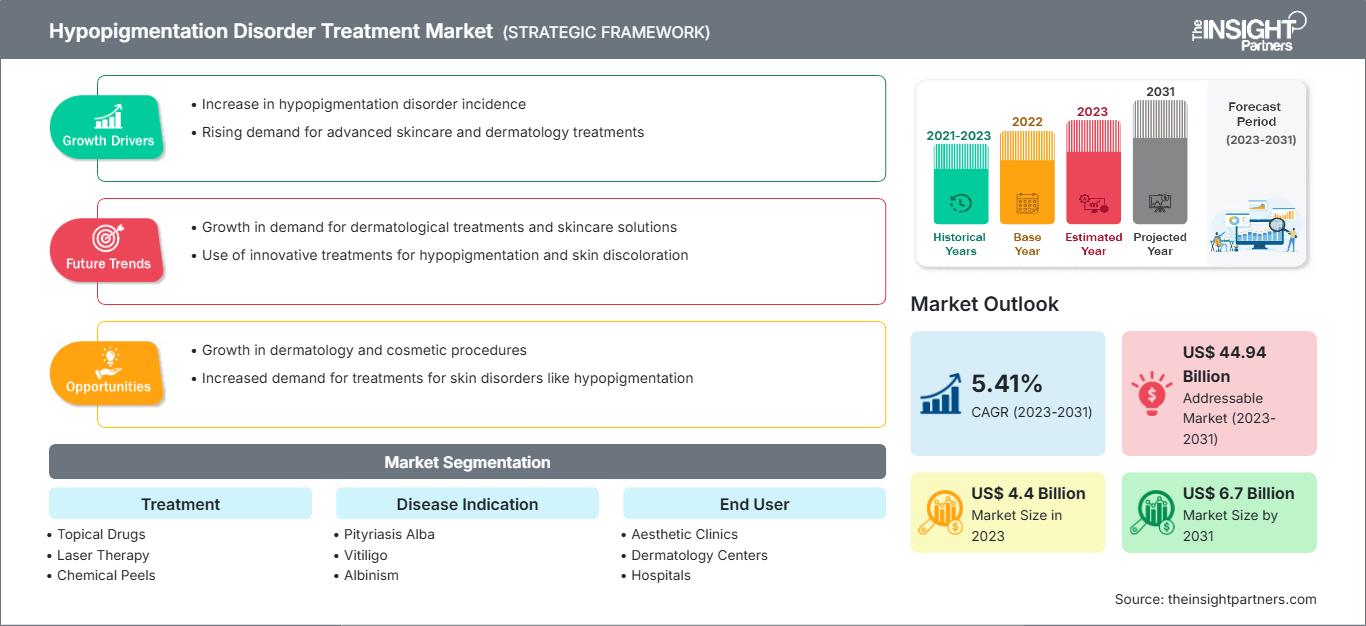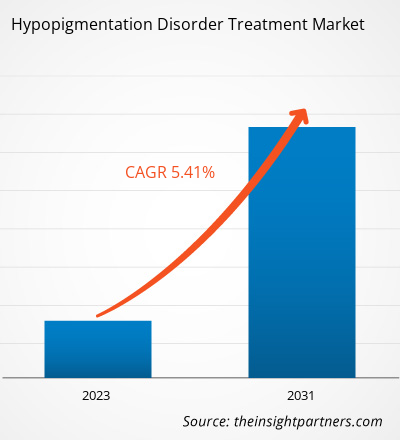[Informe de investigación] Se prevé que el valor del mercado de tratamientos para el trastorno de hipopigmentación crezca de 4.400 millones de dólares estadounidenses en 2023 a 6.700 millones de dólares estadounidenses en 2031; se estima que el mercado registrará una tasa de crecimiento anual compuesta (TCAC) del 5,41% entre 2023 y 2031.
Perspectivas del mercado y opinión de los analistas:
Los trastornos de hipopigmentación pueden evolucionar a trastornos de despigmentación. Se trata de una afección en la que los niveles de pigmento de la piel están por debajo del nivel óptimo, a diferencia de los trastornos de despigmentación que se producen debido a la eliminación completa de pigmentos. Los principales factores que impulsan el crecimiento del mercado de tratamiento de trastornos de hipopigmentación son la creciente concienciación sobre estos trastornos, los avances tecnológicos en tratamientos estéticos y el continuo aumento del envejecimiento de la población. Además, se prevé que el aumento de la incidencia de trastornos relacionados con la hipopigmentación, como el albinismo, la post-hipopigmentación y el vitíligo, impulse el mercado de tratamiento de trastornos de hipopigmentación en los próximos años. Asimismo, se prevé que el creciente gasto de los consumidores en salud cutánea y la concienciación sobre el tratamiento beneficien a este mercado en un futuro próximo. Se espera que la introducción de componentes naturales y de origen vegetal impulse las tendencias del mercado de tratamiento de trastornos de hipopigmentación en los próximos años, ya que estos productos han sido fundamentales para satisfacer la demanda mundial de productos cosmecéuticos hasta la fecha. Por otro lado, el coste de los tratamientos cosméticos y la cirugía limita el crecimiento del mercado.
Según el registro de Ensayos Clínicos Nacionales (NCT), en junio de 2020, Incyte Corporation llevó a cabo un ensayo clínico de fase II con ruxolitinib para evaluar su seguridad y eficacia en el tratamiento del vitiligo en sujetos inscritos en EE. UU. Por lo tanto, el creciente número de ensayos clínicos relacionados con trastornos de hipopigmentación es otro factor clave que impulsa el mercado.
Factores impulsores del crecimiento y desafíos:
El aumento de la prevalencia de los trastornos hipopigmentarios impulsa el crecimiento del mercado
La pitiriasis alba, el vitiligo, el albinismo y la hipopigmentación postinflamatoria se encuentran entre las principales afecciones asociadas a los trastornos de hipopigmentación. El vitiligo es una afección común en todo el mundo. Según un estudio publicado en Dermatology Practical and Conceptual en diciembre de 2023, el vitiligo es una afección cutánea frecuente que afecta a ambos sexos. Sin embargo, es más común en mujeres, y más del 60 % de los pacientes presentan síntomas antes de los 30 años. Se prevé que el aumento de la incidencia y la prevalencia del vitiligo contribuya aún más a la creciente demanda de tratamientos para la hipopigmentación.
Según un artículo publicado en la Revista Médica de la Universidad de Zagazig en marzo de 2023, los trastornos de hipopigmentación son un grupo común de dermatosis en pediatría; su prevalencia varía entre países, oscilando entre el 3,6 % y el 9,9 %. Además, la aparición y adopción de procedimientos mínimamente invasivos, la menor duración de la hospitalización, el menor dolor y las menores complicaciones asociadas a estos procedimientos han sido fundamentales para su creciente popularidad. Según la Sociedad Americana de Cirujanos Plásticos (ASPS), en 2021 el número de procedimientos cosméticos mínimamente invasivos realizados en Estados Unidos aumentó casi un 200 % desde el año 2000. Por lo tanto, la creciente preferencia por estos procedimientos impulsa aún más el crecimiento del mercado de tratamientos para los trastornos de hipopigmentación. Por otro lado, el costo de la fototerapia para afecciones como el vitiligo y el albinismo es elevado. Asimismo, los procedimientos quirúrgicos para tratar el vitiligo son muy costosos. Por lo tanto, el elevado coste de los tratamientos limita su adopción, lo que a su vez limita el crecimiento del mercado de tratamientos para los trastornos de hipopigmentación.
Obtendrá personalización en cualquier informe, sin cargo, incluidas partes de este informe o análisis a nivel de país, paquete de datos de Excel, así como también grandes ofertas y descuentos para empresas emergentes y universidades.
Mercado del tratamiento del trastorno de hipopigmentación: Perspectivas estratégicas

-
Obtenga las principales tendencias clave del mercado que se describen en este informe.Esta muestra GRATUITA incluirá análisis de datos, que abarcarán desde tendencias de mercado hasta estimaciones y pronósticos.
Segmentación y alcance del informe:
El análisis del mercado de tratamientos para trastornos de hipopigmentación se ha realizado considerando los siguientes segmentos: tratamiento, indicación de la enfermedad y usuario final. El alcance geográfico del informe incluye Norteamérica (EE. UU., Canadá y México), Europa (Reino Unido, Alemania, Francia, Italia, España y el resto de Europa), Asia Pacífico (China, Japón, India, Australia, Corea del Sur y el resto de Asia Pacífico), Oriente Medio y África (Emiratos Árabes Unidos, Arabia Saudita, Sudáfrica y el resto de Oriente Medio y África) y Sudamérica y Centroamérica (Brasil, Argentina y el resto de Sudamérica y Centroamérica).
Análisis segmentario:
Perspectivas basadas en el tratamiento
Según el tratamiento, el mercado se segmenta en medicamentos tópicos, terapia láser, peelings químicos, microdermoabrasión, fototerapia y otros. El segmento de medicamentos tópicos tuvo la mayor cuota de mercado en el tratamiento de la hipopigmentación en 2023 y se prevé que registre la mayor tasa de crecimiento anual compuesta (TCAC) entre 2023 y 2031.
Perspectivas basadas en la indicación de la enfermedad
Según la indicación de la enfermedad, el mercado de tratamientos para trastornos de hipopigmentación se segmenta en pitiriasis alba, albinismo, vitiligo, hipopigmentación postinflamatoria y otros. El segmento de vitiligo ostentó una cuota de mercado significativa en 2023 y se prevé que registre la mayor tasa de crecimiento anual compuesto (TCAC) entre 2023 y 2031.
Información basada en el usuario final
En cuanto al usuario final, el mercado se divide en clínicas estéticas, centros dermatológicos y hospitales. El segmento de clínicas estéticas ostentó la mayor cuota de mercado en el tratamiento de trastornos de hipopigmentación en 2023; además, se prevé que registre la mayor tasa de crecimiento anual compuesto (TCAC) del mercado durante el período 2023-2031.
Perspectivas regionales del mercado de tratamientos para el trastorno de hipopigmentación
Los analistas de The Insight Partners han explicado detalladamente las tendencias regionales y los factores que influyen en el mercado del tratamiento de la hipopigmentación durante el período de pronóstico. Esta sección también analiza los segmentos y la geografía del mercado del tratamiento de la hipopigmentación en América del Norte, Europa, Asia Pacífico, Oriente Medio y África, y América del Sur y Central.
Alcance del informe de mercado sobre el tratamiento del trastorno de hipopigmentación
| Atributo del informe | Detalles |
|---|---|
| Tamaño del mercado en 2023 | 4.400 millones de dólares estadounidenses |
| Tamaño del mercado en 2031 | 6.700 millones de dólares estadounidenses |
| CAGR global (2023-2031) | 5,41% |
| Datos históricos | 2021-2023 |
| Período de pronóstico | 2023-2031 |
| Segmentos cubiertos |
Por tratamiento
|
| Regiones y países cubiertos |
América del norte
|
| Líderes del mercado y perfiles de empresas clave |
|
Densidad de los actores del mercado de tratamientos para el trastorno de hipopigmentación: comprensión de su impacto en la dinámica empresarial
El mercado del tratamiento de la hipopigmentación está en rápido crecimiento, impulsado por la creciente demanda de los usuarios finales debido a factores como la evolución de las preferencias de los consumidores, los avances tecnológicos y un mayor conocimiento de los beneficios del producto. A medida que aumenta la demanda, las empresas amplían su oferta, innovan para satisfacer las necesidades de los consumidores y aprovechan las tendencias emergentes, lo que impulsa aún más el crecimiento del mercado.

- Obtenga una visión general de los principales actores del mercado de tratamientos para el trastorno de hipopigmentación.
Análisis regional:
Norteamérica ocupó la mayor participación en el mercado de tratamiento de trastornos de hipopigmentación en 2023 y se proyecta que mantendrá su dominio (en términos de participación) durante el período de pronóstico. Estados Unidos domina el mercado en esta región (con la mayor participación) y a nivel mundial. Una infraestructura sanitaria consolidada, la creciente concienciación de las personas sobre la salud de su piel, la creciente prevalencia de enfermedades asociadas con trastornos de hipopigmentación y la importante presencia de empresas que ofrecen opciones de tratamiento atractivas para pacientes con hiperpigmentación postinflamatoria son algunos de los factores destacados que impulsan el crecimiento del mercado en Norteamérica. Además, la preocupación por la belleza, con el aumento de los estándares de belleza entre los asiáticos, la gran cantidad de empresas que ingresan al mercado y el continuo crecimiento de actores consolidados son algunos de los factores clave que contribuyen a la expansión del tamaño del mercado de tratamiento de trastornos de hipopigmentación en Asia Pacífico.
Panorama competitivo y empresas clave:
El pronóstico del mercado de tratamiento de la hipopigmentación puede ayudar a las partes interesadas en este mercado a planificar sus estrategias de crecimiento. Allergan, SkinCeuticals, Pierre Fabre Group, Incyte Corporation, Episciences Inc., Phio Pharmaceuticals, Obagi Cosmeceuticals LLC, Alvogen, Bella Aurora y AbbVie son algunas de las empresas clave que se describen en el informe de mercado de tratamiento de la hipopigmentación. Estas empresas se centran en ampliar su oferta de productos para satisfacer la creciente demanda de los consumidores en todo el mundo. Su presencia global les permite atender a numerosos clientes.
- Análisis histórico (2 años), año base, pronóstico (7 años) con CAGR
- Análisis PEST y FODA
- Tamaño del mercado, valor/volumen: global, regional y nacional
- Industria y panorama competitivo
- Conjunto de datos de Excel
Informes recientes
Testimonios
Razón para comprar
- Toma de decisiones informada
- Comprensión de la dinámica del mercado
- Análisis competitivo
- Información sobre clientes
- Pronósticos del mercado
- Mitigación de riesgos
- Planificación estratégica
- Justificación de la inversión
- Identificación de mercados emergentes
- Mejora de las estrategias de marketing
- Impulso de la eficiencia operativa
- Alineación con las tendencias regulatorias






















 Obtenga una muestra gratuita para - Mercado de tratamiento de los trastornos de hipopigmentación
Obtenga una muestra gratuita para - Mercado de tratamiento de los trastornos de hipopigmentación